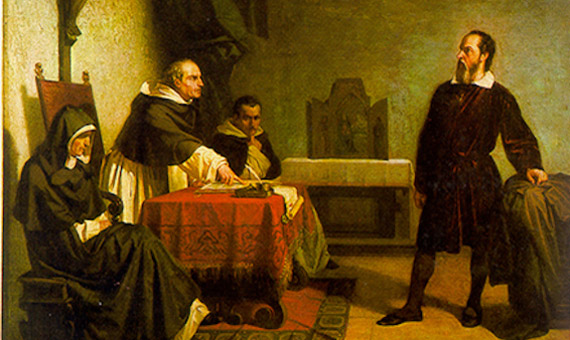“Eppur si muove” (and yet it moves). It is one of the most famous quotes in the history of science, although it is doubtful that the Italian astronomer Galileo Galilei (15 February 1564 – 8 January 1642), to whom it is attributed, ever actually said it, and especially not before the Inquisition that forced him to recant his heliocentric theory. But the appearance of these words, camouflaged in a portrait of Galileo painted by the School of Murillo after the death of the scientist, has brought them into popular culture, founding the idea that the eminent astronomer never renounced his belief.

Galileo was condemned for his theory that the Earth revolved around the Sun, and not the contrary, an idea that on 24 February 1616 the Inquisition of the Catholic Church declared “formally heretical” as well as “foolish and absurd in philosophy.” Heliocentrism had become a matter of theological discussion following Galileo’s work Sidereus Nuncius (Sidereal Messenger) published in 1610. In the work the astronomer brought his telescopic observations to support the heliocentric hypothesis; however, this idea had already been circulating in the celestial treatises for nearly a century.

Heliocentrism had been a cherished approach since ancient times, with its first formulation in the Western world being attributed to the Greek mathematician Aristarchus of Samos in the third century BC. However, it was the Polish Nicolaus Copernicus who, in 1543, refuted the geocentric system of Ptolemy in his book De Revolutionibus Orbium Coelestium (On the Revolutions of the Heavenly Spheres), published shortly before his death, which led to another expression borrowed by science from the vernacular: the Copernican revolution. But although the work of Copernicus is considered one of the foundations of astronomical science, interestingly at the time the Copernican theory did not raise the suspicions of the Catholic Church, which saw the work as a mathematical hypothesis and not an actual physical phenomenon.
It was Galileo who transformed heliocentrism into an explanation of nature when he succeeded in making a hitherto unpublished observation of the firmament thanks to his invention in 1609 of the first practical telescope. Among other reasons, the four moons of Jupiter discovered by Galileo refuted the idea that all heavenly bodies revolve around the Earth as the centre of the universe, and the phases of Venus suggested that this planet orbited around the Sun. The defence of heliocentrism as a practical idea began to bother the Catholic Church, which maintained the literal interpretation of the Bible according to which the Earth is stationary while the sun rises and sets.
But in fact it was not the publication of Galileo’s work that began to arouse a reaction from the Church, but rather a letter that the astronomer sent in 1613 to his former student, Benedetto Castelli, in which he suggested that the interpretation of the Bible should be flexible and should not contradict the observations of nature. In February 1615, a copy of the letter came into the hands of the Congregation of the Holy Office, which on 19 February of the following year convened a commission of theologians to rule on the claims of Galileo. Six days later, the commission published its verdict and ordered Galileo, by means of an injunction, to abandon his “opinion that the sun stands still at the centre of the world and the earth moves” and that he could no longer “hold, teach, or defend it in any way whatever, either orally or in writing.” Otherwise, the document continued, the Holy Office would undertake “proceedings against him.” According to the minutes of the proceedings, Galileo “acquiesed in this injunction and promised to obey.”

Following that episode, the Church banned the works of Copernicus and Galileo. However, in 1632 the Italian’s ideas were ratified in his book Dialogue Concerning the Two Chief World Systems, which led him to be tried by the Inquisition. On 22 June 1633, the astronomer was condemned for heresy and sentenced to indefinite detention, which led him to renounce his ideas in writing and gave rise to the legend of the phrase that he likely never uttered. The next day his sentence was commuted to house arrest. The ban on the works of Copernicus and Galileo remained until 1835, and it was not until 1992 that Pope John Paul II acknowledged the “error of the theologians of the time,” adding that “the Bible does not concern itself with the details of the physical world, the understanding of which is the competence of human experience and reasoning.”
However for the Jesuit and astronomer George Coyne, former director of the Vatican Observatory, the statement of John Paul II perpetuated “a myth” when referring to the case of Galileo as a “tragic mutual incomprehension.” “It is a genuine historical case of a continuing and real contrast between an intrinsic ecclesial structure of authority and the freedom to search for the truth in whatever human endeavour,” Coyne explained to OpenMind. According to the astronomer, the “tragedy” has not been explicitly recognized, which put an end to the career of a man who was “a pioneer of modern science.”
Galileo died in 1642, blind because of glaucoma and still under house arrest. Eppur si muove? The truth is that never broke his oath. Shortly before his death, he wrote, “the falsity of the Copernican system ought not to be doubted in any way, and most of all not by us Catholics who have the undeniable authority of Holy Scripture, interpreted by the best theologians.” But he also added, “if the observations and conjectures of Copernicus are insufficient, those of Ptolemy, Aristotle and their followers are in my view even more false.”
By Javier Yanes for Ventana al Conocimiento
@yanes68
Comments on this publication